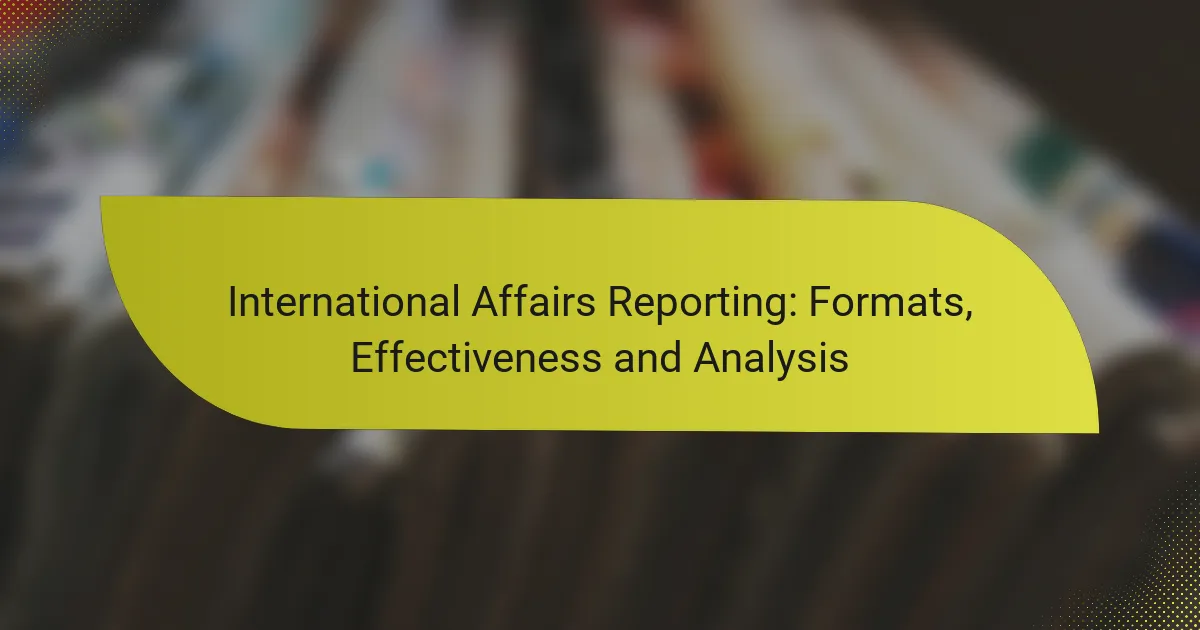International affairs reporting plays a crucial role in shaping public understanding of global events and foreign relations. Various formats, such as print journalism, digital articles, and podcasts, each offer unique advantages for reaching diverse audiences. By adhering to best practices like thorough fact-checking and incorporating multiple perspectives, reporters can provide balanced and credible insights that resonate worldwide.

What are the effective formats for international affairs reporting?
Effective formats for international affairs reporting include print journalism, digital articles, broadcast news, podcasts, and social media updates. Each format has unique strengths and considerations that cater to different audiences and information dissemination needs.
Print journalism
Print journalism remains a traditional yet impactful format for international affairs reporting. Newspapers and magazines often provide in-depth analysis and comprehensive coverage, appealing to readers who prefer detailed narratives and expert opinions.
However, print media faces challenges such as declining circulation and the need for timely updates. Reporters should focus on producing well-researched articles that offer unique insights, as this can help maintain readership in a digital age.
Digital articles
Digital articles are increasingly popular due to their accessibility and immediacy. They can be published quickly, allowing for real-time updates on international events, which is crucial in fast-paced news cycles.
Writers should utilize engaging headlines, multimedia elements, and hyperlinks to enhance the reader’s experience. It’s important to ensure that articles are optimized for search engines to reach a broader audience effectively.
Broadcast news
Broadcast news, including television and radio, provides immediate coverage of international affairs, often featuring live reports and expert interviews. This format is effective for conveying urgency and capturing audience attention through visuals and sound.
However, broadcast news typically offers less depth than print or digital formats. Journalists should aim to balance timely reporting with informative content, ensuring that viewers receive both updates and context.
Podcasts
Podcasts have gained popularity as a format for in-depth discussions on international affairs. They allow for longer conversations and expert insights, making complex topics more accessible to listeners.
To create engaging podcasts, hosts should focus on storytelling and invite diverse guests to provide various perspectives. Regular episodes can help build a loyal audience, but maintaining high production quality is essential for credibility.
Social media updates
Social media updates are vital for real-time engagement and dissemination of international news. Platforms like Twitter and Facebook allow journalists to share breaking news, insights, and interact with audiences instantly.
However, the brevity of social media posts can lead to oversimplification. Journalists should strive to provide accurate information while encouraging followers to seek more comprehensive coverage through links to longer articles or reports.

How does international affairs reporting impact public opinion?
International affairs reporting significantly shapes public opinion by informing citizens about global events and influencing their perceptions of foreign relations. The way these issues are presented can lead to varying levels of concern, support, or opposition among the public.
Influences perceptions of global issues
International affairs reporting plays a crucial role in shaping how people view global issues such as climate change, migration, and conflict. By highlighting specific events or trends, media can elevate certain topics in the public consciousness, leading to increased awareness and concern.
For example, extensive coverage of a humanitarian crisis may prompt public outcry and calls for government action, while minimal reporting on other issues can lead to public indifference. This selective emphasis can significantly affect how individuals prioritize global challenges.
Shapes narratives around foreign policy
The narratives constructed by international affairs reporting can heavily influence public perceptions of a country’s foreign policy. Media framing can either support or challenge government actions, impacting public trust and approval ratings.
For instance, if a news outlet consistently portrays a military intervention as a necessary action for peace, public support may increase. Conversely, if the same intervention is framed as aggressive or unjustified, it may lead to widespread dissent. Understanding these narratives is essential for citizens to critically evaluate foreign policy decisions.

What are the best practices for reporting on international affairs?
Best practices for reporting on international affairs include thorough fact-checking, incorporating diverse perspectives, and maintaining objectivity. These elements ensure accurate, balanced, and credible reporting that resonates with a global audience.
Fact-checking sources
Fact-checking is crucial in international affairs reporting to verify the accuracy of information before publication. Journalists should rely on reputable sources, such as government reports, academic studies, and established news organizations. Cross-referencing multiple sources can help identify discrepancies and confirm facts.
Utilizing tools like fact-checking websites and databases can enhance credibility. For example, organizations like PolitiFact or Snopes can provide insights into the veracity of claims made in international contexts. Always ensure that the sources are current and relevant to the specific issue being reported.
Using diverse perspectives
Incorporating diverse perspectives enriches international affairs reporting by providing a more comprehensive view of complex issues. Engaging voices from different cultural, political, and socioeconomic backgrounds can highlight nuances that a single viewpoint might overlook. This practice fosters empathy and understanding among audiences.
To achieve this, journalists should seek interviews with local experts, activists, and affected individuals. Additionally, including opinions from various stakeholders can help illustrate the multifaceted nature of international events, making the reporting more relatable and impactful.
Maintaining objectivity
Maintaining objectivity is essential for credibility in international affairs reporting. Journalists should strive to present facts without bias, allowing readers to form their own opinions. This involves avoiding emotionally charged language and ensuring that all sides of an issue are represented fairly.
To uphold objectivity, reporters can implement strategies such as separating news from opinion pieces and clearly labeling editorial content. Regularly reviewing and reflecting on personal biases can also help maintain an impartial stance, fostering trust with the audience.

What criteria should be considered when selecting international affairs stories?
Selecting international affairs stories requires careful consideration of relevance, impact, and audience engagement. Key criteria include the story’s connection to current events and its potential effects on local communities.
Relevance to current events
Relevance to current events is crucial when choosing international affairs stories. Stories that align with ongoing global issues, such as climate change, geopolitical tensions, or economic shifts, tend to attract more attention and engagement from audiences.
To assess relevance, consider the timeliness of the story and its connection to major news cycles. A good rule of thumb is to prioritize stories that are either breaking news or have significant updates that affect a wide audience.
Impact on local communities
The impact of international affairs stories on local communities is another vital criterion. Stories that highlight how global events influence local economies, social structures, or cultural dynamics resonate more with readers and can drive community discussions.
When evaluating impact, think about the potential consequences for local populations. For instance, a story about international trade agreements may affect local jobs and businesses, making it more relevant to the audience. Aim to include local perspectives or expert opinions to enhance the story’s significance and relatability.

What are the challenges faced in international affairs reporting?
International affairs reporting faces several challenges, including access to reliable information, political biases, and language barriers. These obstacles can significantly impact the accuracy and objectivity of news coverage across borders.
Access to reliable information
Accessing reliable information is a primary challenge in international affairs reporting. Journalists often rely on local sources, which may be limited or biased, making it difficult to verify facts. In regions with restricted press freedom, obtaining accurate data can be even more problematic.
To navigate this issue, reporters should cross-check information from multiple sources and utilize established international organizations, such as the United Nations or World Bank, which often provide credible data. Building a network of trustworthy local contacts can also enhance the reliability of information gathered.
Political biases
Political biases can distort international affairs reporting, as media outlets may have affiliations that influence their coverage. This can lead to selective reporting, where certain perspectives are emphasized while others are downplayed or ignored. Audiences may receive a skewed understanding of events based on these biases.
To mitigate the effects of political biases, journalists should strive for balanced reporting by presenting multiple viewpoints. Engaging with a diverse range of sources and being transparent about potential biases can help maintain credibility and foster trust with audiences.
Language barriers
Language barriers pose significant challenges in international affairs reporting, as journalists may struggle to accurately convey information from non-English speaking regions. Misinterpretations can lead to misinformation and misrepresentation of events, affecting public perception.
To overcome language barriers, reporters should consider collaborating with local journalists or translators who understand the cultural context. Utilizing technology, such as translation tools, can also assist in bridging communication gaps, but should be used cautiously to ensure accuracy.

How do audiences engage with international affairs reporting?
Audiences engage with international affairs reporting through various platforms, including traditional media, online news outlets, and social media. Their interaction often involves consuming content, sharing insights, and participating in discussions about global events.
Formats of International Affairs Reporting
International affairs reporting comes in multiple formats, including articles, videos, podcasts, and infographics. Each format caters to different audience preferences, with articles providing in-depth analysis, while videos and podcasts offer more accessible and engaging content.
For example, a well-produced documentary can capture the complexities of a geopolitical issue in a way that a written article may not. Infographics can simplify data-heavy topics, making them easier for audiences to understand at a glance.
Effectiveness of Different Reporting Styles
The effectiveness of reporting styles varies based on audience engagement and comprehension. Narrative storytelling often resonates more with readers, as it humanizes issues and connects them emotionally to the content.
Conversely, straightforward reporting that emphasizes facts and data can be effective for audiences seeking quick information. Balancing these styles can enhance overall engagement, as seen in multimedia articles that combine text, visuals, and interactive elements.
Analysis of Audience Engagement Trends
Analyzing audience engagement trends reveals insights into how people consume international affairs reporting. Social media platforms have become vital for sharing news, with users often preferring bite-sized content that can be easily shared and discussed.
Additionally, audience preferences shift over time, influenced by current events and technological advancements. For instance, during significant global crises, audiences may gravitate towards real-time updates and live reporting, highlighting the need for adaptability in reporting strategies.
